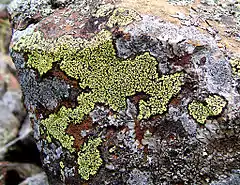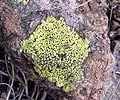Rhizocarpon
Rhizocarpon Ramond ex DC. is a genus of crustose, saxicolous (or sometimes lichenicolous), lecideoid lichens in the family Rhizocarpaceae. The genus is common in arctic-alpine environments, but also occurs throughout temperate, subtropical, and even tropical regions. They are commonly known as the map lichens because of the prothallus forming border-like bands between colonies in some species, like the common map lichen (Rhizocarpon geographicum).
| Rhizocarpon | |
|---|---|
 | |
| Rhizocarpon geographicum | |
| Scientific classification | |
| Kingdom: | |
| Division: | |
| Class: | |
| Order: | Rhizocarpales |
| Family: | |
| Genus: | Rhizocarpon |
| Type species | |
| Rhizocarpon geographicum | |
Taxonomy and phylogeny
Together with three small genera (Catolechia, Poeltinula and Epilichen), Rhizocarpon constitutes the family Rhizocarpaceae.[1][2][3] Historically, ca 389 names have been used.[4] However, many species concepts are ill defined, many names have been synonymized[5] and new species are regularly being described,[6][7][8][9] so true number of species is not entirely clear as of now, but is estimated to be around 200.[8][9][10][11] In molecular work, the genus has also been shown to be paraphyletic, with closely related genera being nested within Rhizocarpon.[2][12]
Common traits
With so many species in a morphologically diverse genus it is difficult to say something general about morphology and anatomy and there will inevitably be some exceptions. However, they do share some key traits. They are all crustose and mostly saxicolous (rock-living), with some being lichenicolous (lichen parasites) on other saxicolous lichens. They are all lecideoid, meaning they have apothecia without a thallus margin containing algae.
Ascus and ascospores
The genus has a distinct type of ascus, the Rhizocarpon-type,[13] which is bitunicate with the inner ascus-wall being slightly apically thickened. Ascospores are considered important characters for determining species within the genus. They are either 2-celled (1-septate) or multi-celled (muriform) and are either hyaline or pigmented (green or brown), often with a characteristic halo (or “perispore”) visible when viewed in a microscope. Asci contain eight, two or rarely one spore.[5][7][10][12]
Some of the species
- Rhizocarpon advenulum
- Rhizocarpon alpicola
- Rhizocarpon amphibium
- Rhizocarpon anaperum
- Rhizocarpon arctogenum
- Rhizocarpon atroflavescens
- Rhizocarpon austroamphibium
- Rhizocarpon badioatrum
- Rhizocarpon bolanderi
- Rhizocarpon caeruleoalbum
- Rhizocarpon caesium
- Rhizocarpon chioneum
- Rhizocarpon cinereovirens
- Rhizocarpon concentricum
- Rhizocarpon dinothetes
- Rhizocarpon diploschistidina
- Rhizocarpon disporum
- Rhizocarpon epispilum
- Rhizocarpon eupetraeoides
- Rhizocarpon eupetraeum
- Rhizocarpon expallescens
- Rhizocarpon furax
- Rhizocarpon furfurosum
- Rhizocarpon geminatum
- Rhizocarpon geographicum
- Rhizocarpon grande
- Rhizocarpon hochstetteri
- Rhizocarpon inarense
- Rhizocarpon infernulum
- Rhizocarpon intermediellum
- Rhizocarpon jemtlandicum
- Rhizocarpon lavatum
- Rhizocarpon lecanorinum
- Rhizocarpon leptolepis
- Rhizocarpon macrosporum
- Rhizocarpon mahreri
- Rhizocarpon mosigiae
- Rhizocarpon nidificum
- Rhizocarpon obscuratum
- Rhizocarpon oederi
- Rhizocarpon oxydatum
- Rhizocarpon petraeum
- Rhizocarpon plicatile
- Rhizocarpon polycarpum
- Rhizocarpon postumum
- Rhizocarpon purpurascens
- Rhizocarpon rapax
- Rhizocarpon reductum
- Rhizocarpon renneri
- Rhizocarpon richardii
- Rhizocarpon ridescens
- Rhizocarpon santessonii
- Rhizocarpon saurinum
- Rhizocarpon simillimum
- Rhizocarpon sorediosum
- Rhizocarpon subareolatum
- Rhizocarpon subgeminatum
- Rhizocarpon sublavatum
- Rhizocarpon superficiale
- Rhizocarpon timdalii
- Rhizocarpon trapeliicola
- Rhizocarpon umbilicatum
- Rhizocarpon viridiatrum
Gallery
 Rhizocarpon sp. on a mountain Zlatibor, Serbia
Rhizocarpon sp. on a mountain Zlatibor, Serbia_Figure_10.jpg.webp) Rhizocarpon pycnocarpoides
Rhizocarpon pycnocarpoides
References
- Hafellner, J. (1984). "Studien in Richtung einer naturlicheren Gliederung der Sammelfamilien Lecanoraceae und Lecideaceae". Nova Hedwigia. 79: 242–366.
- Miadlikowska, J., Kauff, F., Högnabba, F., Oliver, J. C., Molnár, K., Fraker, E., ... & Otálora, M. A. (2014). "A multigene phylogenetic synthesis for the class Lecanoromycetes (Ascomycota): 1307 fungi representing 1139 infrageneric taxa, 317 genera and 66 families". Molecular Phylogenetics and Evolution. 79: 132–168. doi:10.1016/j.ympev.2014.04.003. PMC 4185256. PMID 24747130.CS1 maint: multiple names: authors list (link)
- Lücking, R., Hodkinson, B. P., & Leavitt, S. D. (2017). "The 2016 classification of lichenized fungi in the Ascomycota and Basidiomycota–Approaching one thousand genera". The Bryologist. 119 (4): 361–416. doi:10.1639/0007-2745-119.4.361.CS1 maint: multiple names: authors list (link)
- "Rhizocarpon". MycoBank. Retrieved 2020-03-29.
- Timdal, E., Holtan-Hartwig, J. (1988). "A Preliminary Key tro Rhizocarpon in Scandinavia". Graphis Scripta. 2: 41–54.CS1 maint: multiple names: authors list (link)
- McCune, B., Timdal, E., & Bendiksby, M. (2016). "Rhizocarpon quinonum, a new anthraquinone-containing species from the Alaska Peninsula". The Lichenologist. 48 (5): 367–375. doi:10.1017/S0024282916000347.CS1 maint: multiple names: authors list (link)
- Davydov, E. A., & Yakovchenko, L. S. (2017). "Rhizocarpon smaragdulum, a new monosporic yellow-thalline species and some additional species of the genus Rhizocarpon from the Altai Mountains (Siberia)". The Lichenologist. 49 (5): 457–466. doi:10.1017/S0024282917000469.CS1 maint: multiple names: authors list (link)
- Fryday, A. M., & Kantvilas (2012). "Rhizocarpon austroamphibium (Rhizocarpaceae, lichenized Ascomycota), a new species from Tasmania". Australasian Lichenology. 71: 12–17.CS1 maint: multiple names: authors list (link)
- McCarthy, P.M., Elix, J.A., Kantvilas, G. (2020). "New species and new records of the lichen genus Rhizocarpon from Tasmania, with a key to the Australian taxa". Australasian Lichenology. 86: 36–62.CS1 maint: multiple names: authors list (link)
- Roca-Valiente, B., Hawksworth, D. L., Perez-Ortega, S., Sancho, L. G. & Crespo, A. (2016). "Type studies in the Rhizocarpon geographicum group (Rhizocarpaceae, lichenized Ascomycota)". The Lichenologist. 48 (2): 97–110. doi:10.1017/S002428291500050X.CS1 maint: multiple names: authors list (link)
- Rhizocarpon dinothetes new to Scandinavia, R. Haugan, "Graphis Scripta" Volym 3 (1) 1990
- Ihlen, P. G., & Ekman, S. (2016). "Outline of phylogeny and character evolution in Rhizocarpon (Rhizocarpaceae, lichenized Ascomycota) based on nuclear ITS and mitochondrial SSU ribosomal DNA sequences". Biological Journal of the Linnean Society. Oxford Academic. 77 (4): 535–546. doi:10.1046/j.1095-8312.2002.00127.x.CS1 maint: multiple names: authors list (link)
- Honegger, R. (1980). "The ascus apex in lichenized fungi II. The Rhizocarpon-type" (PDF). The Lichenologist. 12 (2): 157–172. doi:10.1017/S002428298000014X.